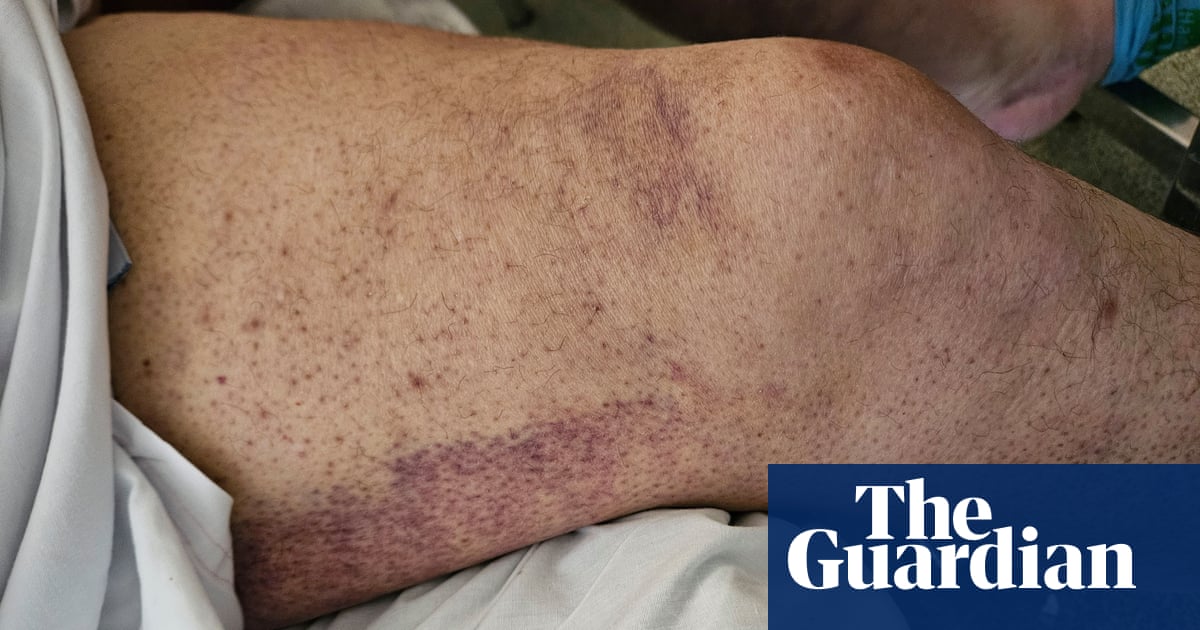Doctors have treated a man for scurvy in Perth, warning what was once considered âa disease of the pastâ is re-emerging due to the rising cost of living.
The condition, caused by severe vitamin C deficiency, was common during the 18th century among sailors who spent months at sea without fresh food. But Australian doctors have described their surprise at seeing it in the present day in an article published on Wednesday in BMJ Case Reports.
A 51-year-old man presented to Sir Charles Gairdner hospital with tiny, painful red-brown pinpoints resembling a rash on his legs.
Doctors conducted extensive investigations, including blood tests, skin biopsies and a CT scan, but they provided no explanation for the underlying cause of the inflammation of his blood vessels and the rash continued to spread while he was in hospital.
The doctors discovered the patient â who was unemployed and lived alone â had financial constraints which meant he mostly ate processed food, lacking in vegetables or fruit. The patient sometimes skipped meals, something which had occurred more frequently in recent weeks.
The patient had undergone bariatric surgery eight years prior to this incident, reducing the size of the stomach. He had stopped taking the vitamin and mineral supplements prescribed for him after surgery because he was unable to afford them.
Dr Andrew Dermawan, a senior registrar at the hospital, ordered blood tests to assess his nutritional status which came back indicating no detectable levels of vitamin C and very low levels of other key nutrients.
The diagnosis of scurvy came as a surprise, Dermawan, the lead author of the article, told Guardian Australia. âItâs not something that I expected to come up in todayâs time.â
The body needs vitamin C to produce collagen, the tissue that makes up skin and connects muscle and bone. Severe deficiency can weaken the collagenâs triple-helix structures as well as blood capillaries, resulting in blood spots in the skin, as well as microscopic bleeding in urine.
The patientâs symptoms resolved after the doctors prescribed him 1,000mg of vitamin C daily, as well as a vitamin D3 supplement, folic acid, and a multivitamin, in addition to a meal plan created by a dietitian. Of his own initiative, âhe also started eating a lemon dailyâ.
This disease is easily reversible with vitamin C supplements, with a dramatic response seen within 24 hours, but scurvy is often overlooked because it is considered a disease of the past, Dermawan said.
Quick Guide
11 foods you might not realise are ultra-processed
Show
Bread
– Most pre-sliced bread available in supermarkets contains modified starches and additives like emulsifiers and vegetable gums â even the healthy-sounding multiseed or sourdough loaves.
Processed meat
– Bacon, sausages, and deli-sliced cold meats like ham and salami can be full of emulsifiers, thickeners, modified starches, added fibre, and even added colours and flavouring.
Vegan meat
– Vegan âfake meatsâ like burgers, sausage, and bacon might be packaged in green and decorated with plants, but theyâre highly processed and often contain emulsifiers, unlike whole food sources of vegetarian protein like mushrooms or beans.
Plant milks
– Many plant milks and vegan cheese products are ultra-processed, containing emulsifiers, vegetable gums, stabilisers and flavours. But some skip the additives, like a soy milk of just water, soybeans, oil and salt.
Breakfast cereal
– Many cereals and breakfast drinks contain maltodextrins, added colours, and processed proteins and fibres.
Muesli bars and protein balls
– Protein bars and âhealth ballsâ might be a pantry staple for health-conscious snackers but theyâre full of processed fibres and proteins, sweeteners and modified sugars.
Ready to eat meals
– Ready meals can be pumped full of additives to stop them going stale on the shelf. The longer the ingredient list, the more likely the dish is ultra-processed.
Yoghurts
– Flavoured yoghurts often contain more additives than plain yoghurts. Check the ingredients list for thickeners, sweeteners or flavours.
Cooking sauces
– Jar sauces for pasta or stir-fry often have thickeners, flavour enhancers or colours that wouldnât be found in a sauce made from scratch at home.
Margarine
– Margarine can only be made by ultra-processing vegetable oils, and is often boosted with emulsifiers and colours. Butter is not ultra-processed.
Baby foods
– Some baby foods are ultra-processed, with cereals, biscuits and rusks marketed at infants particularly exposed. Nearly a third of baby foods sold in the UK are ultra-processed.
The article includes a âlearning pointâ for other doctors, noting âscurvy is a re-emerging disease with the rising cost of livingâ. It points to the rising cost of food in Australia, making families more reliant on lower-cost foods, which tend to be poorer in nutritional value.
The article also highlighted that the patientâs obesity, previous bariatric surgery and low-income status were also among his risk factors for developing scurvy.
after newsletter promotion
Dermawan explained that because the stomach produces enzymes to break down nutritional components, people who have had part of their stomach removed through bariatric surgery can have trouble absorbing nutrients, making it a risk factor for scurvy alongside alcoholism, gastrointestinal disorders and being on dialysis.
In 2016, diabetic patients at Westmead hospital in western Sydney were found to have symptoms of scurvy and reported they ate few vegetables, or overcooked them, destroying vitamin C.
Dr Tim Senior, the chair of the Royal College of General Practitionersâ specific interest group on poverty and health, said it was an important case report as the man could be a âcanary in the coalmineâ.
âWhat theyâre describing in terms of cost-of-living pressures and the inability to afford good food, I think we are seeing more of that, definitely, and that will result in probably a whole range of micronutrient deficiencies, such as scurvy.â
While scurvy was the most notable diagnosis, Senior noted the man also had other nutrient deficiencies.
Senior, who works for Tharawal Aboriginal Corporationâs medical service in western Sydney, said he had seen patients losing weight because they couldnât afford to eat.
Senior said poorer communities who are already known to be more likely to be in the unhealthy weight range are often more greatly affected by the problem of excess calories without nutrition. That in turn can result in conditions like obesity, which the authors identified as a risk factor for scurvy.
âFinancial resources affect peopleâs health quite clearly ⦠The way around that is understanding thatâs happening, acting on the cost-of-living crisis, so that everyone should be able to afford the food that keeps them well,â Senior said.



